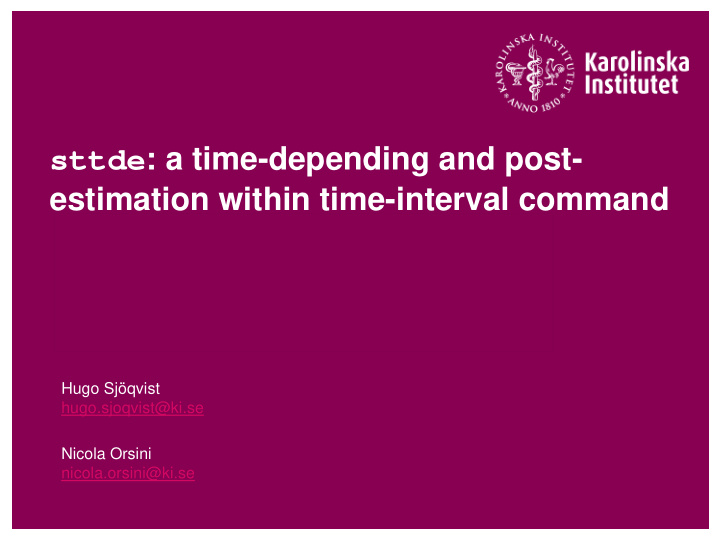



sttde : a time-depending and post- estimation within time-interval command Hugo Sjöqvist hugo.sjoqvist@ki.se Nicola Orsini nicola.orsini@ki.se
Exposure data of income (Year_1990-Year_2015) collected over 25 years, with record of the death of the individual Start End Death Year_1990 Year_1991 …… Year_2014 Year_2015 1991 2013 0 3423 5431 3456 6641 2005 2014 1 5321 2341 4321 . 1998 2015 0 . . 5464 5431 1990 1995 0 342 453 224 156 1995 2015 1 . 7585 4257 1335 2001 2014 1 21235 4523 4568 . 2008 2009 1 23854 124 . . Hugo Sjöqvist 02/10/2019 2
Other possible research questions Applied example 1. What is the association between suicide and being a parent, and how does it change during the adult’s lifespan? Applied example 2. How long does it take for immigrants from specific regions to utilize the Swedish health care system to the same length, or more as a Swedish native? Hugo Sjöqvist 02/10/2019 3
The assumption of proportionality and time- dependence, in survival analysis A common setting in survival analysis is that exposure is recorded at baseline and then it is assumed to stay constant. However, exposures and covariates may change over time. Ignoring this fact may lead to misleading and uninformative results (eg. Yearly income at migration) Time-depending survival analysis, in short, is to divide the individual’s follow-up at the time-point when the exposure changes. Hugo Sjöqvist 02/10/2019 4
What is sttde ? The program has several functions 1. Re-structure and manage the data to fit a time-depending analysis. 2. Use previous information of the user’s survival analysis input to estimate a general time-depending regression model. 3. If chosen by the user, estimate within time-intervals of the study period to be able to examine the change of the estimates over time. 4. Receive graphically the exposure’s estimates over time for a clearer understanding (with Stata’s own graphical twoway layout, making the user able to design them as he/she wishes). The program also functions by ignoring step 1, granting the user an informative picture of the behavior of a non-time-depending exposure (recorded at baseline) over time. Hugo Sjöqvist 02/10/2019 5
Possible structure of the data Hugo Sjöqvist 02/10/2019 6
Code to execute program Minimum required code streg : the regression model to be used – default is cox regression type : continuous, categorical (with or without chosen ref.) – default is continuous eform : the Efron method to handle tied failures – Breslow is default adjustfor : covariates or non-time depending exposures to be included in the model tb : specification of the within-time estimation – excluding will yield only the overall estimate Hugo Sjöqvist 02/10/2019 7
Code to execute program Hugo Sjöqvist 02/10/2019 8
Hazard ratios within intervals of the time- scale (age) Hugo Sjöqvist 02/10/2019 9
Applied example 1: The association between children and parents’ suicide* A Swedish population study measuring the association the number of children have with the risk of parents taking their own life at a later date. The men and women entered the study at earliest the year of 1990 or at the age of 20, whichever occurred last. They were followed until 2011, or at loss of follow-up. Due to the young age of most individuals, the number of children recorded at the baseline was few – leading us to treating the exposure as time-depending . *” Parenthood and lower risk of suicide in women and men ” (in manuscript). Main author: Alma Söderberg Wallin, Karolinska Institutet (alma.sorberg.wallin@ki.se) Hugo Sjöqvist 02/10/2019 10
Applied example 1: The association between children and parents’ suicide (ref. Alma) Hugo Sjöqvist 02/10/2019 11
Applied example 1: The association between children and parents’ suicide (ref. Alma) Hugo Sjöqvist 02/10/2019 12
Applied example 2: Estimation of time to psychiatric care use among migrants, compared to Swedish born citizens* Sweden has, to a certain extent, free healthcare and people in need of psychiatric care is always greatly encourage to contact and utilize it. It is not surprising to assume that migrants being granted citizenship in Sweden does not fully understand or grasp the healthcare system, to the same extent as people born in the country, at the start. This study examined the association between migration status and utilizing psychiatric healthcare in Sweden, compared to Swedish born. The exposure here is not treated as time-depending . *” Psychiatric care use among migrants to Sweden compared with natives – a longitudinal cohort study of 5,682,485 people in Sweden ” (in manuscript). Main author: Anna-Clara Hollander, Karolinska Institutet (anna-clara.hollander@ki.se) Hugo Sjöqvist 02/10/2019 13
Applied example 2: Estimation of time to psychiatric care use among migrants, compared to Swedish born citizens. (ref. Anna-Clara) Hugo Sjöqvist 02/10/2019 14
Future work Keep designing it so it can handle as many “stset” approaches as possible. Calibrate the program so the computational speed decreases. Adding more options to the sttde command. Hugo Sjöqvist 02/10/2019 15
Recommend
More recommend